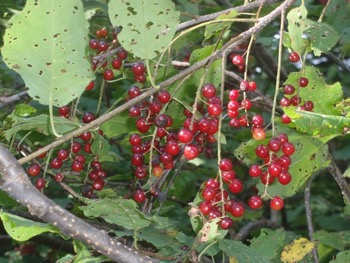
Hunt Where the Food Is
The first major mast crop that you take notice of in August when you're out in the woods are choke cherries, and their garnet clusters seem to be everywhere out there this year. They are a favorite of many birds and animals, with black bears perhaps favoring them the most, and I'm sure that our grouse also get in on the action as well. They are an "early" food and are usually entirely gone from the scene when we're out there grouse hunting in October and November.
Wild apple trees remain the quintissential fall food for grouse, and they really become a staple wherever they are present following some hard frosts that drop the fruit to the ground. In a short time, they become mushy and easily digestible for the birds and are a guaranteed spot to check on for grouse. There are a few old apple orchards that have gotten in to our rotation of coverts over the years, and while they seem to usually have birds in them, that does not mean that they are always areas of hunter success. I have noticed many times that the birds that frequent the orchards are very skittish (even for grouse), as if they know that they are undertaking something of a commando mission to take the chance of feeding there. We usually hunt these spots as silently as possible (no bells, no beepers, no talking) to try to take the birds by surprise, but that still rarely works.
The best day in one of these old apple orchards came probably five or six years ago following the first sticking snowfall of the year (it was in mid-October and we had received 4"-5"). We bumbled in to 18 grouse that afternoon (yes, just the afternoon, in one covert), and it was undoubtedly because we were intercepting birds that had come in to feed with the cold weather. My clients harvested none. Old apple orchards also tend to be good areas for woodcock here and there - the soil composition is perfect for worm production, so timberdoodles can be sought in under the shade of an old apple tree too.
Another important food source are high bush cranberries, which linger perhaps the longest of all the food sources. They last well in to winter, and sometimes right through it. A couple of these natural food patches are on our roster of coverts as well, and they can be pretty dependable, particularly early in the morning or just before dark. The proof of how important high bush cranberries are to wildlife came a few years ago when I was driving through downtown Canaan, Vermont. There, in the middle of town, not fifty feet from someone's house, was a mature wild turkey in a high bush cranberry bush, hammering it for all it was worth. They must be good.
The last natural food source that's big with our ruffed grouse up here is the Mountain Ash (Sorbus Americana) - it also lasts well in to winter and is there for the grouse when other food sources have dried up. Some years, it seems like they're everywhere, and other years the crop doesn't seem too good and I'm not sure why. This year looks to be a fantastic one for production, as their bright red berry clusters are prevalent wherever I drive - can't miss them, and hopefully our grouse don't miss them either!
